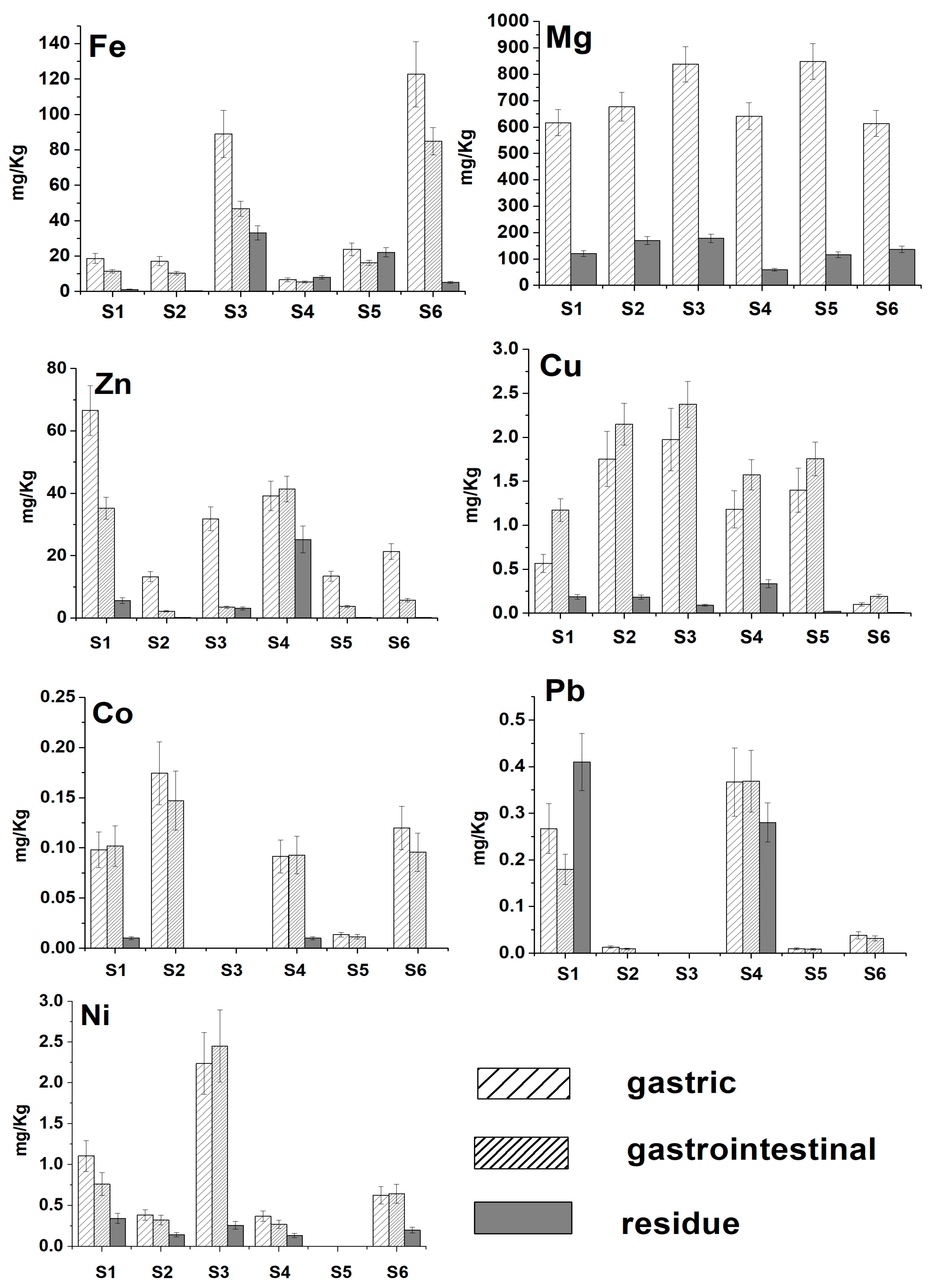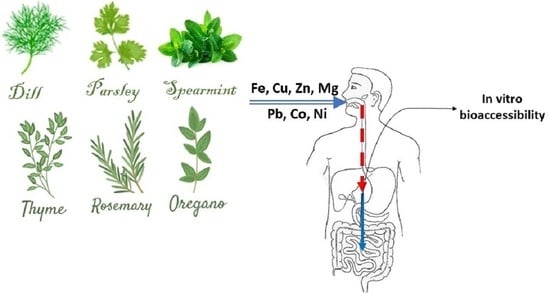In Vitro Assessment of the Physiologically Relevant Oral Bioaccessibility of Metallic Elements in Edible Herbs Using the Unified Bioaccessibility Protocol
Abstract
:1. Introduction
2. Results and Discussion
2.1. Total Content of Essential Elements and Heavy Metals
2.2. Bioaccessibility of Metallic Elements
3. Materials and Methods
3.1. Reagents and Solutions
3.2. Instrumentation
3.3. Samples
3.4. Sample Preparation and Determination of Metal Ions
3.5. In Vitro Simulation of Gastrointestinal Digestion
3.6. Principle Components and Cluster Analysis
4. Conclusions
Supplementary Materials
Author Contributions
Funding
Institutional Review Board Statement
Informed Consent Statement
Data Availability Statement
Conflicts of Interest
References
- Van Wyk, B.-E. Food Plants of the World Identification, Culinary Uses, and Nutritional Value; CABI: Wallingford, UK, 2019; ISBN 978-1-78924-130-3. [Google Scholar]
- Hoffmann, D. Medical Herbalism: The Science Principles and Practices of Herbal Medicine; Healing Arts Press: Rochester, VT, USA, 2003; ISBN 978-0892817498. [Google Scholar]
- Fernández-García, E.; Carvajal-Lérida, I.; Pérez-Gálvez, A. In Vitro Bioaccessibility Assessment as a Prediction Tool of Nutritional Efficiency. Nutr. Res. 2009, 29, 751–760. [Google Scholar] [CrossRef] [PubMed]
- Carbonell-Capella, J.M.; Buniowska, M.; Barba, F.J.; Esteve, M.J.; Frígola, A. Analytical Methods for Determining Bioavailability and Bioaccessibility of Bioactive Compounds from Fruits and Vegetables: A Review. Compr. Rev. Food Sci. Food Saf. 2014, 13, 155–171. [Google Scholar] [CrossRef] [PubMed]
- Dima, C.; Assadpour, E.; Dima, S.; Jafari, S.M. Bioavailability and Bioaccessibility of Food Bioactive Compounds; Overview and Assessment by in vitro Methods. Compr. Rev. Food Sci. Food Saf. 2020, 19, 2862–2884. [Google Scholar] [CrossRef] [PubMed]
- Rein, M.J.; Renouf, M.; Cruz-Hernandez, C.; Actis-Goretta, L.; Thakkar, S.K.; da Silva Pinto, M. Bioavailability of Bioactive Food Compounds: A Challenging Journey to Bioefficacy. Br. J. Clin. Pharmacol. 2013, 75, 588–602. [Google Scholar] [CrossRef] [PubMed] [Green Version]
- Hur, S.J.; Lim, B.O.; Decker, E.A.; McClements, D.J. In Vitro Human Digestion Models for Food Applications. Food Chem. 2011, 125, 1–12. [Google Scholar] [CrossRef]
- Ng, J.C.; Juhasz, A.; Smith, E.; Naidu, R. Assessing the Bioavailability and Bioaccessibility of Metals and Metalloids. Environ. Sci. Pollut. Res. 2015, 22, 8802–8825. [Google Scholar] [CrossRef]
- BARGE–The Bioaccessibility Research Group of Europe. BARGE Unified Bioaccessibility Method. 2009. Available online: https://www2.bgs.ac.uk/barge/ubm.html (accessed on 12 June 2023).
- Souza, L.A.; Souza, T.L.; Santana, F.B.; Araujo, R.G.O.; Teixeira, L.S.G.; Santos, D.C.M.B.; Korn, M.G.A. Determination and in vitro Bioaccessibility Evaluation of Ca, Cu, Fe, K, Mg, Mn, Mo, Na, P and Zn in Linseed and Sesame. Microchem. J. 2018, 137, 8–14. [Google Scholar] [CrossRef]
- Herrera-Agudelo, M.A.; Miró, M.; Arruda, M.A.Z. In Vitro Oral Bioaccessibility and Total Content of Cu, Fe, Mn and Zn from Transgenic (through Cp4 EPSPS Gene) and Nontransgenic Precursor/Successor Soybean Seeds. Food Chem. 2017, 225, 125–131. [Google Scholar] [CrossRef]
- Tokalıoğlu, Ş.; Clough, R.; Foulkes, M.; Worsfold, P. Bioaccessibility of Cr, Cu, Fe, Mg, Mn, Mo, Se and Zn from Nutritional Supplements by the Unified BARGE Method. Food Chem. 2014, 150, 321–327. [Google Scholar] [CrossRef]
- Intawongse, M.; Kongchouy, N.; Dean, J.R. Bioaccessibility of Heavy Metals in the Seaweed Caulerpa racemosa Var. Corynephora: Human Health Risk from Consumption. Instrum. Sci. Technol. 2018, 46, 628–644. [Google Scholar] [CrossRef] [Green Version]
- Xu, X.; Wang, J.; Wu, H.; Lu, R.; Cui, J. Bioaccessibility and Bioavailability Evaluation of Heavy Metal(Loid)s in Ginger in vitro: Relevance to Human Health Risk Assessment. Sci. Total Environ. 2023, 857, 159582. [Google Scholar] [CrossRef]
- Tokalıoğlu, Ş. Bioaccessibility of Cu, Mn, Fe, and Zn in Fruit and Vegetables by the In Vitro UBM and Statistical Evaluation of the Results. Biol. Trace Elem. Res. 2023, 201, 1538–1546. [Google Scholar] [CrossRef] [PubMed]
- Hedges, L.J.; Lister, C.E. Nutritional Attributes of Herbs; Crop & Food Research Confidential Report No. 1891; New Zealand Institute for Crop & Food Research Limited: Christchurch, New Zealand, 2007. [Google Scholar]
- Tsogas, G.Z.; Giokas, D.L.; Kapakoglou, N.I.; Efstathiou, D.E.; Vlessidis, A.G.; Dimitrellos, G.N.; Georgiadis, T.D.; Charchanti, A.V. Land-Based Classification of Herb’s Origin Based on Supervised and Unsupervised Pattern Recognition of Plant and Soil Chemical Profiling. Anal. Lett. 2010, 43, 2031–2048. [Google Scholar] [CrossRef]
- Munir, N.; Jahangeer, M.; Bouyahya, A.; El Omari, N.; Ghchime, R.; Balahbib, A.; Aboulaghras, S.; Mahmood, Z.; Akram, M.; Ali Shah, S.M.; et al. Heavy Metal Contamination of Natural Foods Is a Serious Health Issue: A Review. Sustainability 2021, 14, 161. [Google Scholar] [CrossRef]
- Hu, J.; Wu, F.; Wu, S.; Cao, Z.; Lin, X.; Wong, M.H. Bioaccessibility, Dietary Exposure and Human Risk Assessment of Heavy Metals from Market Vegetables in Hong Kong Revealed with an in vitro Gastrointestinal Model. Chemosphere 2013, 91, 455–461. [Google Scholar] [CrossRef]
- Yang, L.; Yang, Y.; Tian, W.; Xia, X.; Lu, H.; Wu, X.; Huang, B.; Hu, W. Anthropogenic Activities Affecting Metal Transfer and Health Risk in Plastic-Shed Soil-Vegetable-Human System via Changing Soil PH and Metal Contents. Chemosphere 2022, 307, 136032. [Google Scholar] [CrossRef]
- Intawongse, M.; Dean, J.R. Use of the Physiologically-Based Extraction Test to Assess the Oral Bioaccessibility of Metals in Vegetable Plants Grown in Contaminated Soil. Environ. Pollut. 2008, 152, 60–72. [Google Scholar] [CrossRef]
- Mills, M.M.; Ridame, C.; Davey, M.; La Roche, J.; Geider, R.J. Iron and Phosphorus Co-Limit Nitrogen Fixation in the Eastern Tropical North Atlantic. Nature 2004, 429, 292–294. [Google Scholar] [CrossRef]
- Broadley, M.R.; White, P.J.; Hammond, J.P.; Zelko, I.; Lux, A. Zinc in Plants. New Phytol. 2007, 173, 677–702. [Google Scholar] [CrossRef] [PubMed]
- Intawongse, M.; Dean, J.R. In-Vitro Testing for Assessing Oral Bioaccessibility of Trace Metals in Soil and Food Samples. TrAC Trends Anal. Chem. 2006, 25, 876–886. [Google Scholar] [CrossRef]
- Pelfrêne, A.; Waterlot, C.; Guerin, A.; Proix, N.; Richard, A.; Douay, F. Use of an in vitro Digestion Method to Estimate Human Bioaccessibility of Cd in Vegetables Grown in Smelter-Impacted Soils: The Influence of Cooking. Environ. Geochem. Health 2015, 37, 767–778. [Google Scholar] [CrossRef]
- Sandström, B. Micronutrient Interactions: Effects on Absorption and Bioavailability. Br. J. Nutr. 2001, 85, S181. [Google Scholar] [CrossRef]
- Tuntipopipat, S.; Zeder, C.; Siriprapa, P.; Charoenkiatkul, S. Inhibitory Effects of Spices and Herbs on Iron Availability. Int. J. Food Sci. Nutr. 2009, 60, 43–55. [Google Scholar] [CrossRef]
- Filipiak-Szok, A.; Kurzawa, M.; Szłyk, E. Simultaneous Determination of Selected Anti-Nutritional Components in Asiatic Plants Using Ion Chromatography. Eur. Food Res. Technol. 2016, 242, 1515–1521. [Google Scholar] [CrossRef] [Green Version]
- Konietzny, U.; Greiner, R. Phytic Acid: Nutritional Impact, 2nd ed.; Academic Press: Cambridge, MA, USA, 2003; ISBN 9780122270550. [Google Scholar]
- Li, Y.; Demisie, W.; Zhang, M. The Function of Digestive Enzymes on Cu, Zn, and Pb Release from Soil in vitro Digestion Tests. Environ. Sci. Pollut. Res. 2013, 20, 4993–5002. [Google Scholar] [CrossRef]
- Steinhart, H.; Beyer, M.G.; Kirchgeßner, M. Zur Komplexbildung von Proteinen Mit Cu2+-Ionen Im Sauren Milieu. Z. Lebensm Unters Forsch. 1975, 159, 73–77. [Google Scholar] [CrossRef] [PubMed]
- Poggio, L.; Vrščaj, B.; Schulin, R.; Hepperle, E.; Ajmone Marsan, F. Metals Pollution and Human Bioaccessibility of Topsoils in Grugliasco (Italy). Environ. Pollut. 2009, 157, 680–689. [Google Scholar] [CrossRef]
- Koplík, R.; Borková, M.; Mestek, O.; Komínková, J.; Suchánek, M. Application of Size-Exclusion Chromatography–Inductively Coupled Plasma Mass Spectrometry for Fractionation of Element Species in Seeds of Legumes. J. Chromatogr. B 2002, 775, 179–187. [Google Scholar] [CrossRef]
- Fu, J.; Cui, Y. In Vitro Digestion/Caco-2 Cell Model to Estimate Cadmium and Lead Bioaccessibility/Bioavailability in Two Vegetables: The Influence of Cooking and Additives. Food Chem. Toxicol. 2013, 59, 215–221. [Google Scholar] [CrossRef] [PubMed]
- Paustenbach, D.J.; Tvermoes, B.E.; Unice, K.M.; Finley, B.L.; Kerger, B.D. A Review of the Health Hazards Posed by Cobalt. Crit. Rev. Toxicol. 2013, 43, 316–362. [Google Scholar] [CrossRef] [PubMed]
- Wojcieszek, J.; Ruzik, L. Study of Bioaccessibility of Cobalt Species in Berries and Seeds by Mass Spectrometry Techniques. J. Anal. Sci. Technol. 2020, 11, 26. [Google Scholar] [CrossRef]
- Danzeisen, R.; Williams, D.L.; Viegas, V.; Dourson, M.; Verberckmoes, S.; Burzlaff, A. Bioelution, Bioavailability, and Toxicity of Cobalt Compounds Correlate. Toxicol. Sci. 2020, 174, 311–325. [Google Scholar] [CrossRef] [PubMed] [Green Version]
- Liang, J.-H.; Lin, X.-Y.; Huang, D.-K.; Xue, R.-Y.; Fu, X.-Q.; Ma, L.Q.; Li, H.-B. Nickel Oral Bioavailability in Contaminated Soils Using a Mouse Urinary Excretion Bioassay: Variation with Bioaccessibility. Sci. Total Environ. 2022, 839, 156366. [Google Scholar] [CrossRef] [PubMed]



| Fe | Mg | Zn | Cu | Co | Pb | Ni | |
|---|---|---|---|---|---|---|---|
| Parsley | 35.9 ± 5.2 | 719.7 ± 88 | 111.4 ± 17 | 2.4 ± 0.8 | 0.2 ± 0.1 | 0.9 ± 0.1 | 2.0 ± 0.08 |
| Dill | 39.8 ± 4.7 | 768.2 ± 101 | 17.6 ± 2.6 | 5.4 ± 0.8 | 0.3 ± 0.1 | <LOD | 0.8 ± 0.08 |
| Spearmint | 156.2 ± 25 | 454.0 ± 76 | 46.7 ± 5.5 | 6.1 ± 1.1 | <LOD | <LOD | 6.3 ± 0.9 |
| Oregano | 19.4 ± 3.8 | 830.1 ± 91 | 138.9 ± 21 | 3.9 ± 1.0 | 0.2 ± 0.1 | 1.0 ± 0.2 | 0.8 ± 0.1 |
| Thyme | 58.1 ± 5.4 | 922.5 ± 98 | 16.8 ± 3.3 | 3.9 ± 0.8 | <LOD | <LOD | <LOD |
| Rosemary | 236.0 ± 27 | 682.1 ± 84 | 28.4 ± 4.2 | 0.3 ± 0.1 | 0.2 ± 0.1 | 0.1 ± 0.1 | 1.6 ± 0.5 |
Disclaimer/Publisher’s Note: The statements, opinions and data contained in all publications are solely those of the individual author(s) and contributor(s) and not of MDPI and/or the editor(s). MDPI and/or the editor(s) disclaim responsibility for any injury to people or property resulting from any ideas, methods, instructions or products referred to in the content. |
© 2023 by the authors. Licensee MDPI, Basel, Switzerland. This article is an open access article distributed under the terms and conditions of the Creative Commons Attribution (CC BY) license (https://creativecommons.org/licenses/by/4.0/).
Share and Cite
Choleva, T.G.; Tziasiou, C.; Gouma, V.; Vlessidis, A.G.; Giokas, D.L. In Vitro Assessment of the Physiologically Relevant Oral Bioaccessibility of Metallic Elements in Edible Herbs Using the Unified Bioaccessibility Protocol. Molecules 2023, 28, 5396. https://doi.org/10.3390/molecules28145396
Choleva TG, Tziasiou C, Gouma V, Vlessidis AG, Giokas DL. In Vitro Assessment of the Physiologically Relevant Oral Bioaccessibility of Metallic Elements in Edible Herbs Using the Unified Bioaccessibility Protocol. Molecules. 2023; 28(14):5396. https://doi.org/10.3390/molecules28145396
Chicago/Turabian StyleCholeva, Tatiana G., Charikleia Tziasiou, Vasiliki Gouma, Athanasios G. Vlessidis, and Dimosthenis L. Giokas. 2023. "In Vitro Assessment of the Physiologically Relevant Oral Bioaccessibility of Metallic Elements in Edible Herbs Using the Unified Bioaccessibility Protocol" Molecules 28, no. 14: 5396. https://doi.org/10.3390/molecules28145396
APA StyleCholeva, T. G., Tziasiou, C., Gouma, V., Vlessidis, A. G., & Giokas, D. L. (2023). In Vitro Assessment of the Physiologically Relevant Oral Bioaccessibility of Metallic Elements in Edible Herbs Using the Unified Bioaccessibility Protocol. Molecules, 28(14), 5396. https://doi.org/10.3390/molecules28145396









